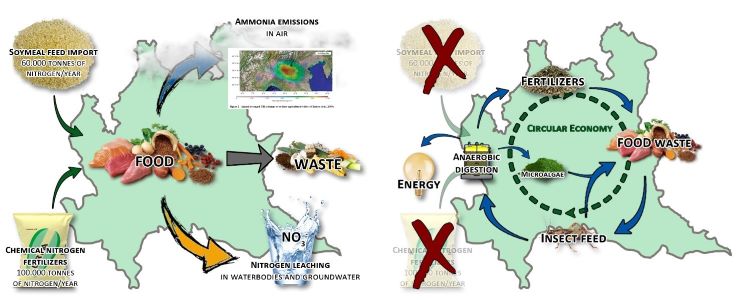SUSTAINABLE MODEL FOR AGROENERGY AND FEED PRODUCTION BY URBAN WASTE RECYCLING AND TREATMENT – SMART FEED
About 6,071,512 t y-1 in Italy and 1.2 million t y-1 in Lombardy of organic fraction (OFMSW) from separate collection are available. Composting and anaerobic digestion used to transform OFMSW into useful products do not allow to sustain economically these processes. The OFMSW contains large amount of organic matter of high biological value suggesting its recovering to produce high added-value products, fertilizers and energy. The large volume of feed for livestock sector (soy) imported from extra EU countries makes the EU largely dependent for protein supply. In this way, local protein production become a key priority for EU-food politics. In Lombardy Region, the import of protein causes, also, the input of 60.000 t y-1 of nitrogen (N) affecting environment, i.e. waters and air quality, so that the production of local protein closing the nitrogen-protein cycle would beneficially affect the environment.
Poultry farms are located in the northern regions of Italy and are characterized by high production intensity. The increase in the consumption of poultry meat and eggs creates the demand for new feed ingredients with highly digestible protein, desirable amino acid composition and high content in essential Poly Unsaturated Fatty Acids (PUFA) to support sustainable intensive production and high health level in animals. Modern agriculture uses chemical fertilizers (100.000 N t y-1 only in Lombardy) increasing costs and environmental problems because of nutrient overload, being this problem increased by N imported as protein. In this context, an effective nutrient recovery (N and P) as fertilizers will reduce this problem promoting a real Circular Economy and closing wastes loop.
A Circular Economy is a “productive system aimed at minimising waste and making the most of resources. In a circular system resource input and waste, emission, and energy leakage are minimized by slowing, closing, and narrowing energy and material loops”. Taking into consideration this definition and basing on on the Key Themes before indicated, SMART-Feed aims to propose a local circular economy model promoting the production of healthy feed for poultry by growing insects on OFMSW, and microalgae on the liquid fraction of digestate. Required energy will come from anaerobic digestion (AD) of residual wastes and the waste loop will be closed by producing fertilizers to be used in a modern agriculture promoting the use of renewable fertilizers.
More info
https://users.unimi.it/ricicla/
CONTACTS
Fabrizio Adani
Fabrizio.adani@unimi.it

